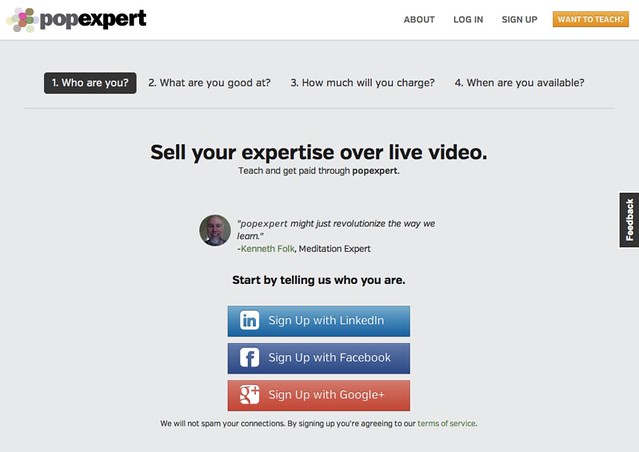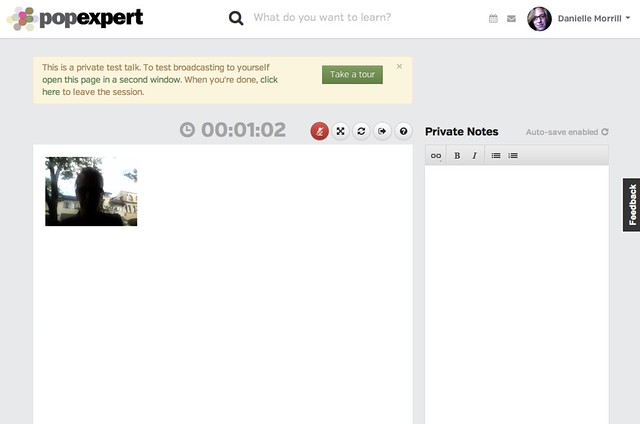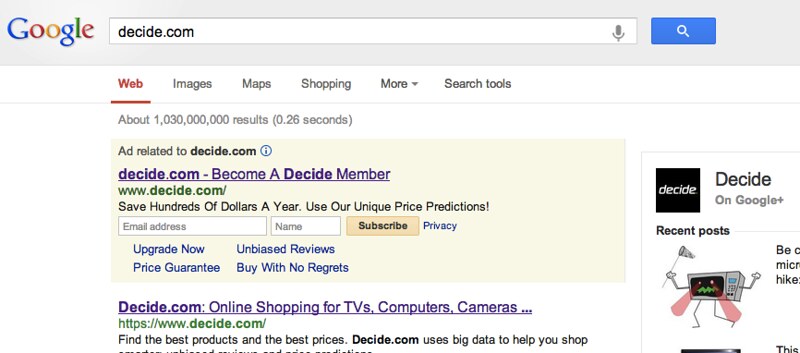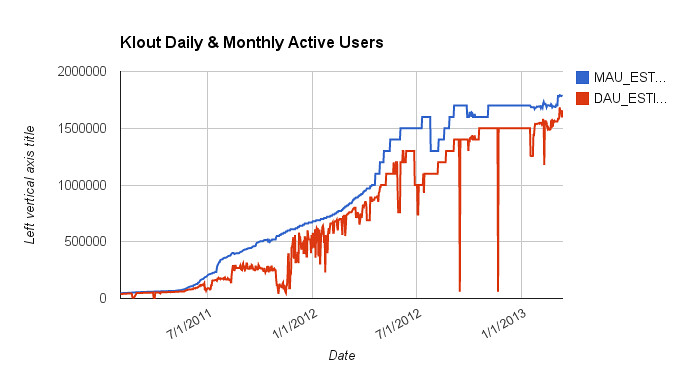Posts
-
PopExpert Raises $500,000 Seed Round for Lifelong Learning Marketplace
 San Francisco based PopExpert has raised a seed round for its live video service, according to documents filed with the SEC. The website connects people who want to learn new skills to a broad range of experts, let’s learners search by price and availability, and handles the scheduling and payments. Yesterday they featured 3 popular guitar teachers offering lessons on their site, and have experts in other areas like nutrition, entrepreneurship, software development and many more categories.
San Francisco based PopExpert has raised a seed round for its live video service, according to documents filed with the SEC. The website connects people who want to learn new skills to a broad range of experts, let’s learners search by price and availability, and handles the scheduling and payments. Yesterday they featured 3 popular guitar teachers offering lessons on their site, and have experts in other areas like nutrition, entrepreneurship, software development and many more categories.
Experts can sign up to offer their services, set their own price and manage their sessions through Pop Expert – making it somewhat similar to Clarity which allows individuals to manage phone based “clarity calls” offering coaching, expertise, and advice.

According to Facebook, I have 1 friend already using this app and it is being used by 300 others – pretty awesome traction for a company that appears to be flying a bit below the radar until now. I’ve signed up to teach so I hope you’ll come check out my profile and sign up for an available time slot.


I just tested out my video connection, and I’m ready to rock.


PopExpert is cofounded by CEO Ingrid Sanders and CTO Jeremy Thomas, who share a background at The Active Network and the service is currently in private beta. You can visit their website to request an invitation.
-
Is Digg “A Thing” Again?
Ars Technica tech policy writer Timothy B. Lee tweeted this morning that news aggregation service Digg is “a thing” again, which I hope means he’s seen some meaningful traffic and distribution of one or more of his pieces through the service.
My traffic stats suggest that digg is a thing again.
— Timothy B. Lee (@binarybits) April 4, 2013
After being purchased by Betaworks last year Digg has undergone a makeover, and some bloggers lamented that this previously regular source of traffic wasn’t what it used to be. Are you seeing an uptick in traffic from Digg distribution of your stories?
-
Startup Investment Hits 3.5 Year Low in December, Q1 M&A Slowest Since 1995
According to investments reported in the Crunchbase database, this winter investment dollars flowing to startup companies reached low point not seen since May 2009.

Even more concerning, on Monday the National Venture Capital Association reported that venture-backed IPO exits fell to a 3 year low in the first quarter of 2013, while M&A was at its lowest point since 1995.
According to the article:
The number of venture-backed IPO exits during the first quarter of 2013 fell 58 percent compared to the first quarter of last year. For the first quarter of 2013, 77 venture-backed M&A deals were reported, 10 of which had an aggregate deal value of $984.3 million, a 73 percent decrease from the first quarter of 2012. This marks the slowest quarter for number of disclosed deals since the first quarter of 1995*, when eight disclosed deals were completed.
“First quarter IPO and acquisitions activity is often subdued as year-end reporting and forward planning take priority, but this year political, taxation, and sequestration concerns weighed even more heavily on the exit market for emerging growth companies. Therefore, activity was especially slow,” said John Taylor, head of research for NVCA. “That said, public market valuations have been up recently, 2012 financial statements are being finalized now, and quality companies tell us they are starting the process toward an exit later in the year. Despite having waited for the right opportunity to move forward, the 2013 class of companies that goes public or gets acquired will have to be solid. Barring significantly adverse events, we expect stronger volume in the second and third quarters.”
*emphasis added
I’m unclear why the tech press did not report on this, and can only speculate they were too busy curating lists of April Fools Day pranks to notice. Or maybe they thought this was a bad joke from the NVCA?
-
Indexing the Andreessen Horowitz Portfolio Companies – Pinterest, Twitter and Github on Top
Over the past few weeks I’ve been indexing groups of startups, starting with the Y Combinator index and 500 Startups index. I’ve received a lot of requests for other indexes, and the company whose portfolio everyone wanted to look at was that of the Silicon Valley venture capital firm Andreessen Horowitz.
Portfolio Overview
Andreessen Horowitz has an impressive list of exited companies in 3 IPOs (Facebook, Groupon, Zynga) and 3 acquisition from high profile companies: Nicira (acquired by VMWare), Instagram (acquired by Facebook), and Skype (acquired by Microsoft).
For this post my research covers companies that have not yet exited.

Andreessen Horowitz Consumer Startup Index
Andreessen Horowitz Enterprise Startup Index
The enterprise index is entirely based on traffic at this point, since Facebook MAUs aren’t useful for this segment of companies. We are working on collecting more useful revenue / unit economics data for ranking these companies and know this does not accurately reflect their progress. For example Apptio is in the #31 spot but is preparing for a possible IPO.
Methodology
The index takes into account website traffic ranking globally, as provided by Alexa, along with a weighted average of Facebook monthly active users (MAUs). While traffic is only one part of the story, how it changes over time can provide a useful proxy for evaluating how the company’s reach and attention received from others. There are many other indicators of a companies health that I will take into consideration in future indexes, but for now this is presented as a very simple overview of the companies. I split apart the consumer vs. enterprise companies to make it more of an apples to apples comparison.
I have also included Quantcast rankings, as many people seem to think they are more credible. Overall I found their data set had too many gaps to be useful, although we may weigh it into the average in the future.
Editor’s Note: This is the first index of this portfolio so it does not show each company’s change in rankings over time. I will show that in the next index of this portfolio, one month from now.
Missing Companies
These companies are taken from the AH website, Crunchbase, AngelList and other public announcements. If I missed something please let me know in the comments or email me at danielle (at) refer.ly
-
The Stable Song – Gregory Alan Isakov
remember when our songs where just like prayers.
like gospel hymns that you called in the air.
come down come down sweet reverance,
unto my simple house and ring…
and ring.ring like silver, ring like gold
ring out those ghosts on the ohio
ring like clear day wedding bells
were we the belly of the beast or the sword that fell…we’ll never tell.come to me clear and cold on some sea
watch the world spinning waves..like some machinenow i’ve been crazy couldn’t you tell
i threw stones at the stars, but the whole sky fell
now i’m covered up in straw, belly up on the table
well and sang and drank, and passed in the stable.that tall grass grows high and brown,
well i dragged you straight in the muddy ground
and you sent me back to where i roam
well i cursed and i cried, but now i know…now i knowand i ran back to that hollow again
the moon was just a sliver back then
and i ached for my heart like some tin man
when it came oh it beat and it boiled and it rang..its ringingring like crazy, ring like hell
turn me back into that wild haired gale
ring like silver, ring like gold
turn these diamonds straight back into coal. -
Purity Ring “Grammy”
-
Watsi and the Future of Patronage
This post is part of my continuous coverage of Y Combinator Demo Day for the Winter 2013 Class. You can see all publicly launched companies from today’s presenters here, Watsi is currently ranked #7.
—
While Watsi will probably not take in capital on traditional VC terms, I hope they can capture the imagination of some folks in the audience and gain new donors.
.png?1332528504) Today Watsi, a non-profit for funding medical treatments, is presenting on stage at Y Combinator Demo Day by cofounders Chase Adam, Jesse Cooke, and Grace Garey. The company made quite a splash back in January when they were announced as the first non-profit to receive funding from YC.
Today Watsi, a non-profit for funding medical treatments, is presenting on stage at Y Combinator Demo Day by cofounders Chase Adam, Jesse Cooke, and Grace Garey. The company made quite a splash back in January when they were announced as the first non-profit to receive funding from YC.Hilarious by @paulg “There’s one company here today that’s a nonprofit. An intentional nonprofit!”
— Sundeep Peechu (@speechu) March 26, 2013
I am admittedly a bit of a curmudgeon when it comes to donating to charity, but after seeing Watsi present yesterday and reading this post “The Bacon Wrapped Economy” about the end of cultural patronage as we know it, it got me to thinking. Maybe this is exactly the kind of platform people like me can get behind.
The East Bay Express paints a bleak picture the future for philanthopy, suggesting that our outcomes-focused giving will fail to build the kinds of institutions that have perserved American culture for the past 300 years.
And according to Medak and other members of the art world, it’s not just the donors themselves who are changing; it’s the entire ethos — and that may mark a change in a system that’s been more or less the same since the Renaissance. “A lot of those philanthropic dollars are now going to programs with measurable outcomes,” Medak said. “This shift toward a more transactional relationship in philanthropy, where you give something and expect to get something concrete back, has continued to escalate. The entrepreneurial infatuation we have now — and I don’t mean that in a loaded way — comes with a notion that the things we’re investing in should have a potential to [make] returns. It’s antithetical to the kind of philanthropy that has built institutions in this country.” Medak didn’t mention the logical, eventual corollary to this — that an end to institution-building philanthropy can also mean an end to the institutions themselves — but it doesn’t feel entirely far off.
I’m not so bearish. In fact, I wonder if the Internet can finally bring the meaning and accountability that has been lacking for young donors who won’t be building a hospital in their name, but simply want to feel they’ve made an impact on an issue they care about.
Old Money, Old Mindset?
The post goes on to explain that most patronage typically comes from older generations who have had a lifetime to accumulate their wealth. I can hardly complain – visiting the local museums, structures, monuments, artwork and other results of this philanthropy is a pleasure. I would never make the argument that this is an either/or situation where all funds should move away from arts and toward solving the world’s problems.
However, I think charitable giving needs to be aligned with the values of the people donating money, and it’s possible that those values have shifted for a younger generation toward institutions that solve real world problems.
In the case of Watsi, the public is clearly in support of a new institution that works to support those in need of medical attention around the world. Operating like a startup and providing an unbelievable amount of transparency is mostly a marketing gimmick today, but long term it could reset the expectations for a new generation of givers.
Today’s Demo Day at the Computer History Museum attracts high net worth individuals, investors and professionals looking to put their charitable giving to work, so while Watsi will probably not take in capital on traditional VC terms I hope they can capture the imagination of some folks in the audience and gain meaningful new donorship.
 Wish them luck today, and take a moment to make a donation to Oumar, a 19 month old child whose life is threatened by meningitis and chronic epilepsy. He needs just $1370 to save his life, and 100% of your donation goes directly to his treatment.
Wish them luck today, and take a moment to make a donation to Oumar, a 19 month old child whose life is threatened by meningitis and chronic epilepsy. He needs just $1370 to save his life, and 100% of your donation goes directly to his treatment.It’s been 2 years since @chaseadam17 imagined Watsi.org. Today we’re pitching at @ycombinator‘s Demo Day twitter.com/watsi/status/3…
— Watsi (@watsi) March 26, 2013
-
Did I Just See the Future of Advertising?
Have you ever seen the ability to capture leads directly from search before, with email subscription directly in an ad? I just saw this on Google for the first time while sleuthing around trying to figure out the Decide.com announcement apparently happening tomorrow morning. I can’t currently find a way to create my own lead form in Google Adwords, and I haven’t ever seen this on any other search result. Is this the future, capturing leads without ever leaving the search results?

Looks Like It Worked
Subscribing to the email newsletter doesn’t take you off Google to Decide.com, you get a confirmation right in your search results. Google on!

Not Sure How I Missed This
The SEOmoz community were among the first to play with this feature, as one post in this thread says:
Yep its a communication ad extension – it wasn’t open to all advertisers at first. You need to check in your account to see if you can add this extention in camp/adword settings if you dont see it then contact adwords support, it was trialing, but might now be live for one and all…
It sounds like this feature is still in beta and limited to certain accounts. If I were so lucky as to have an account manager I’d hit him up, but in the meantime I’m curious to see who else is playing with this feature for customer aquisiton. It seems powerful.
-
The Y Combinator Startup Index
 In a former life I served as Editor of Seattle 2.0, and one of the most popular pieces of content we produced was the Seattle 2.0 Index – a monthly ranked list of all the local startups. It was a labor of love by Marcelo Calbucci and I was never a part of making it, but I always loved seeing how my favorite companies were doing and discovering new ones. I always thought it would be fun to make something similar for Silicon Valley, but it turns out there are a lot more startups here (I know, I know). To test drive the idea I’m starting with the companies from Y Combinator who haven’t exited, and are still operating.
In a former life I served as Editor of Seattle 2.0, and one of the most popular pieces of content we produced was the Seattle 2.0 Index – a monthly ranked list of all the local startups. It was a labor of love by Marcelo Calbucci and I was never a part of making it, but I always loved seeing how my favorite companies were doing and discovering new ones. I always thought it would be fun to make something similar for Silicon Valley, but it turns out there are a lot more startups here (I know, I know). To test drive the idea I’m starting with the companies from Y Combinator who haven’t exited, and are still operating.There are plenty of flaws with rankings like this because traffic and Facebook monthly active users hardly tell the full story of any company and it compares web to mobile, social to enterprise, and on and on. What is valuable is seeing how things change over time. This is the first index, so it doesn’t have the month over month comparison. What it does reveal is that some companies you might not hear about every day in the press are doing really well.
Important: This does not include companies in the current YC batch.
Take a look, let me know what you think, who I missed, or any other feedback. You can read about the methodology at the bottom of this post. I will update this with any corrections and leave an update note.
Methodology
The ranking is based on Alexa traffic rankings first, and Facebook monthly active users second. Right now it doesn’t factor in the iOS or Android rankings because the data is very limited. The MAU numbers are weighted as a percentage of the total MAU across all the companies, multiplied by ten, and subtracted from the Alexa rank. It sounds simplistic, but looking at the list it seems to make sense. I’m open to feedback on mkaing it better.
-
As LinkedIn Passes 1 Billion Profile Endorsements, Has Klout Stagnated?
Klout, the company that calculates your individual influence score based on your engagement on various social media sites like Twitter and Facebook, feels stagnant. To make matters worse, last week TechCrunch reported that LinkedIn’s new endorsements feature is kicking serious butt. From the article:
“Today, LinkedIn is announcing that Endorsements has passed the 1 billion milestone — with 58 million members getting recognition on their profiles for different areas of expertise, according to a blog post from Peter Rusev. The marker is a sign that, were LinkedIn so inclined, it could likely give sites likes Klout, which measure influencer status, a run for their money.” – read full article on TechCrunch
I logged into Klout for the first time in months today, and it felt like a veritable ghost town. Not only have my friends stopped talking about it or sharing their scores in the past few months, but according to Alexa the website is showing slowly declining traffic at a stage when it should be growing — losing most of the ground it appears to have gained since early 2011.

On the other hand, their Facebook app monthly and daily active user data suggests they’ve recently had some growth following a long plateau period – so maybe people are just more active with Klout on mobile?

So What’s Going On?
Klout offers users perks, which are special offers and coupons brands want to give to people with certain behaviors or demographic information. The idea is that I will test out these products and then talk to my friends about them. In the past I’ve been offered awesome perks like a free Nike Fuel Band or free 3-day test drive of the Acura ILX, but logging into is a lot less exciting. My perks include a $5 McDonalds card, $15 off Chilis, and a free Norton Mobile Security pack ($30 value) among others.
Back in the early days when that was a thing I connected my Facebook and Twitter accounts to Klout because I was curious about my “score” (a number 1 to 100 which tells you how influential you are relative to others), and when they launched their iPhone app I installed it. Now I get mobile push notifications when my score goes up and down and often tap the alert to check it out – which I guess makes me an “active” for that day or month. I’m pretty sure Klout’s sales team goes to big brands and sells them on accessing these active users with their offers… but is it really working?
Doing the Math
According this January 2012 funding announcement the company was pre-revenue at that time.
The company has more than 4,000 API partners, up from around 100 in early 2010. And it has indexed north of 100 million public profiles. A few million people have actively registered on Klout.com in order to tie their various social profiles together (and boost their Klout scores). reported by TechCrunch
Sources confirm that the company is now doing paid deals and brought on a COO over the summer of 2012 to focus on ramping revenue and improving operational efficiency.
Brand partnerships with McDonald’s and others probably pay healthy sums (I’m thinking $50-100k month per month or engagement), but if my perks are any indication the offerings to consumers aren’t particularly compelling.
Klout has raised $40M raised to date, including a strategic investment from Microsoft about 6 months ago. The company is 5 years old with around 80 full time employees. With a big beautiful office, daily catered meals and a substantial sales and biz dev team I could easily see them burning $1M+ a month ($10k per employee fully loaded + $200k G&A), which means they could be nearing halfway through the $30M raised in early 2012.
What Do You Think?
Do you regularly use Klout to track your personal influence (daily, weekly, monthly)? Have you worked with them to do a brand placement reaching influencers and seen meaningful ROI? Is the future bright for paid promotions to social media influencers? Let me know why or why not in the comments.
—
Danielle is an early Klout adopter, her score is 69.
